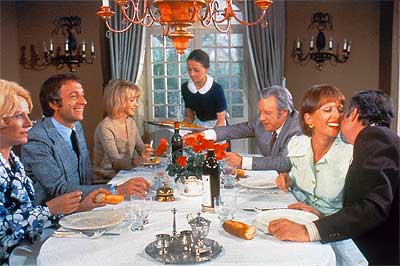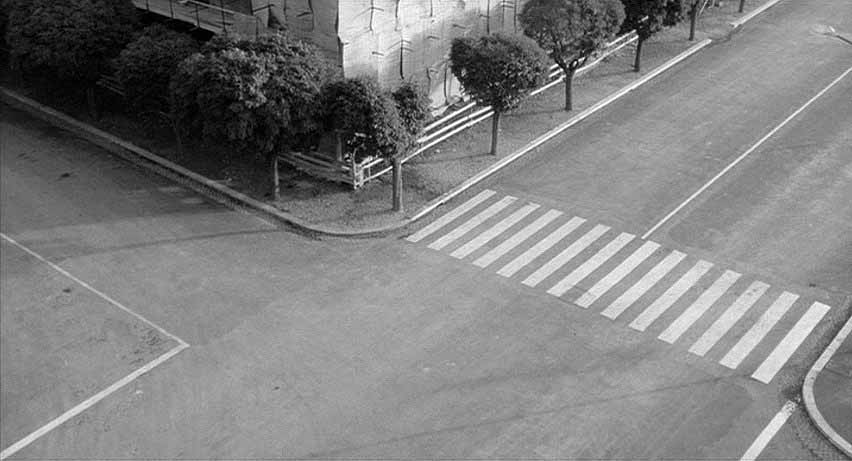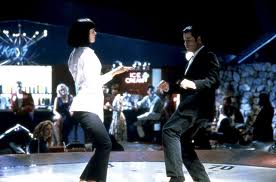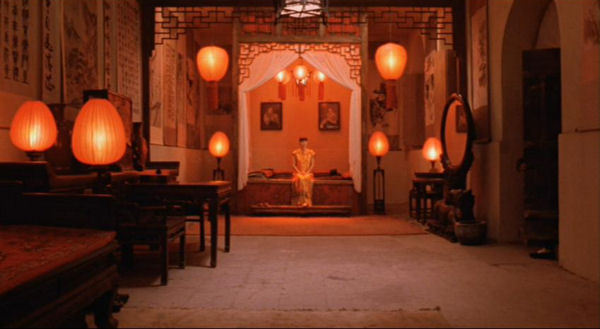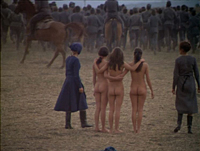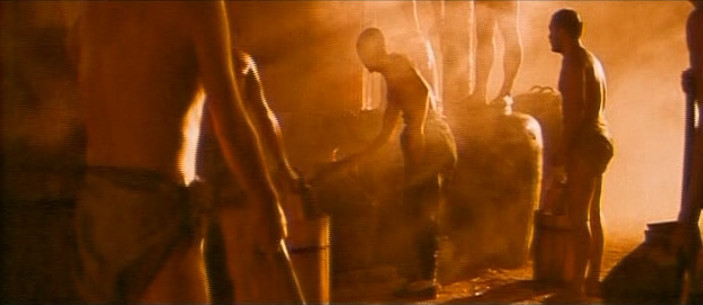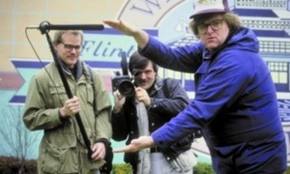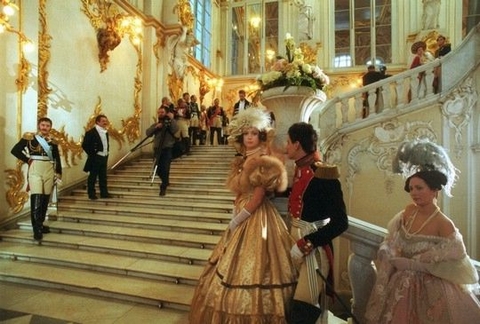These are expanded Chicago Reader capsules written for a 2003 collection edited by Steven Jay Schneider. I contributed 72 of these in all; here are the second dozen, in alphabetical order. — J.R.
The Discreet Charm of the Bourgeoisie
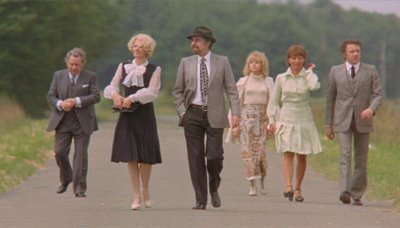
Luis Buñuel’s 1972 comic masterpiece, about three well-to-do couples who try and fail to sit down and have a meal together, is perhaps the most perfectly achieved and executed of all his late French films. The film proceeds by diverse interruptions, digressions, and interpolations (including dreams, dreams within dreams, and tales within tales) that, interestingly enough, identify the characters, their class, and their seeming indestructibility with the very processes of narrative illusion and narrative continuity themselves — their rewards as well as their compulsions, their pleasures and their frustrations.
Frightening, funny, profound, and mysterious, the various episodes involving these and other characters (including Jean-Pierre Cassel and Paul Frankeur) are like an anthology of Buñuel’s themes, favorite gags, and recurring nightmares. The film was produced by Serge Silberman and coscripted by Jean-Claude Carrière, perhaps the two most essential friends and collaborators in the flowering of Bunuel’s late period, though Buñuel regulars Rey, Frankeur, and Julien Bertheau might also be cited. (Rey plays the ambassador from an imaginary country named Miranda that clearly has multiple resemblances to Spain.)
One of the things that makes this film as charming as it is, despite its radicalism, and helped Buñuel to win his only Oscar, is the perfect cast, many of whom bring along nearly mythic associations acquired in previous films. Thus Delphine Seyrig makes us think of Last Year at Marienbad, Stéphane Audran summons up the high bourgeoisie (and high gloss) of Claude Chabrol’s middle period, Bulle Ogier’s neurotic is like a light-comic version of the mad character she played in L’Amour fou, and even Fernando Rey unmistakably calls to mind The French Connection when he brandishes some cocaine. (One suspects that Carrière had a hand in some of these references.)
Shortly after this film was nominated for an Oscar, Buñuel was interviewed by reporters while having lunch in a Mexican restaurant, and when they asked if he expected to win, his reply was immediate: “Of course. I’ve already paid the $25,000 they wanted. Americans may have their weaknesses, but they do keep their promises.” (JR)
The Eclipse
The conclusion of Michelangelo Antonioni’s loose trilogy about modern life at mid-century (preceded by L’avventura and La notte), this 1961 film is conceivably the greatest in Antonioni’s career, but perhaps significantly it has the least consequential plot. A sometime translator (Monica Vitti) recovering from an unhappy love affair briefly links up with a stockbroker (Alain Delon) in Rome, though the stunning final montage sequence — perhaps the most powerful thing Antonioni has ever done — does without these characters entirely. And because these two leads arguably give the most nuanced and charismatic performances of their careers here, the shock of losing them before the end of the picture is central to the film’s devastating final effect.
Alternately an essay and a prose poem about the contemporary world in which the “love story” figures as one of many motifs, this is remarkable both for its visual/ atmospheric richness and its polyphonic and polyrhythmic mise en scène. Antonioni’s handling of crowds at the Roman stock exchange is never less than amazing, recalling the choreographic use of deep focus employed in the early features of Orson Welles, where foreground and background details are juggled together in brilliant juxtapositions.
But it is probably the final sequence, which depends on editing rather than mise en scène, that best sums up the hope and despair of the filmmaker’s vision. (JR)
The House is Black
Forugh Farrokhzad’s 20-odd-minute black-and-white 1962 documentary about a leper colony in northern Iran is the most powerful Iranian film I’ve seen —- the most poetic as well as the most radically humanist. Farrokhzad (1935-1967) is commonly regarded as the greatest Persian poet of the 20th century, and one of her poems can be heard recited by the hero in Abbas Kiarostami’s The Wind Will Carry Us (whose title is that of the poem). Her only film —- which reflects the probable influence of silent Soviet cinema without being in any way obviously derivative of it — seamlessly adapts the techniques of poetry to its framing, editing, sound, and narration. (The latter is split between two voices: the male voice, belonging to Ebrahim Golestan–the film’s producer, Farrokhzad’s lover, and a considerable filmmaker in his own right —- is mainly objective and factual; the female voice is Farrokhzad’s, offering a poetic and highly emotional reverie about her subject that incorporates passages from the Old Testament.) At once lyrical and extremely matter-of-fact, devoid of sentimentality or voyeurism yet profoundly humanist, the film offers a view of everyday life in the colony — people eating, various medical treatments, children at school and at play — that’s spiritual, unflinching, and beautiful in ways that have no apparent Western counterparts; to my eyes and ears, it registers like a prayer. (JR)

La notte
Michelangelo Antonioni’s 1961 follow-up to his groundbreaking L’avventura is the middle feature in a loose trilogy ending with Eclipse that was made at the height of his intellectual prestige in the international film scene. Repeating many of the melancholic themes and stylistic moves of its predecessor, with particular emphasis on the boredom and atrophied emotions of the rich, La notte ends with the kind of regretful recollection of former sexual desire that characterizes the final scene of James Joyce’s short story “The Dead”. For better and for worse, the mainstream cliches that would circulate throughout the 60s about Antonioni as a highbrow director making boring film about the bored rich stem largely from the excesses of this feature — despite the fact that it also shows some of the filmmaker’s most subtle and modulated work.
This feature’s success as a structured and shapely narrative is somewhat more mixed than that of either L’avventura (1960) or L’eclisse (1962), and the performances are generally better than those of the former and not as good as those in the latter. The minimal plot, restricted to less than 24 hours, involves the death of passion between a successful novelist (Marcello Mastroianni) and his frustrated wife (Jeanne Moreau). The best parts of this movie tend to cluster around the beginning and end, and include the novelist’s brief encounter with a nymphomaniac patient at a hospital while visiting a dying friend (Bernhard Wicki) and his much longer encounter with the daughter (Monica Vitti) of an industrialist at a party, both of which foreground his shifting impulses and moods. Both these sequences show Antonioni’s mise-en-scene at its most intricately plotted and emotionally subtle. By contrast, probably the worst section is an extended walk taken by the wife around Milan, full of symbolic and pretentious details meant to suggest her mental state, which arguably shows some of the ill effects that Ingmar Bergman had on certain filmmakers during the early 60s. Yet whatever one’s occasional misgivings, this feature comes from what is widely and justifiably considered to be Antonioni’s richest period, and evidence of his stunning mastery is apparent throughout. (JR)
Pulp Fiction
A couch potato’s paradise, this highly clever and immensely entertaining 1994 second feature by Quentin Tarantino is a chronologically scrambled collection of interrelated and interlocking crime stories. Apart from its ingenious structure, it extracts nearly all its kicks from allusions to and echoes of other movies and TV shows, and despite all its thematic nudges about redemption and second chances its true agenda is only the flip side of Forrest Gump: to make the escapist, media-savvy viewer the real hero of the story. Taken on its own crass terms, Tarantino’s mock-tough narrative — which derives most of its titillation from farcical mayhem, drugs, deadpan macho monologues, evocations of anal penetration, and terms of racial abuse –resembles a wet dream for 14-year-old male closet queens (or, perhaps more accurately, the 14-year-old male closet queen in each of us), and his command of this smart-alecky mode is so sure and confident that this nervy movie sparkles throughout with canny twists and turns.
John Travolta, Samuel L. Jackson, Bruce Willis, and Harvey Keitel all vibrate with high-voltage star power, while the rest of the cast (Uma Thurman, Ving Rhames, Maria de Medeiros, Tim Roth, Amanda Plummer, Eric Stoltz, Rosanna Arquette, Christopher Walken, and Tarantino) amply fill out the remaining scenery. Only occasionally — as in an overloaded and ugly basement episode and some anemic love scenes — does Tarantino seem to be straining, though even here his overall project is evident: to evict real life and real people from the art film and replace them with generic teases and assorted hommages, infused with hype and attitude, building a veritable monument to the viewer’s assumed connoisseurship. The references range from Douglas Sirk to Howard Hawks to Saturday Night Fever to kung fu by way of Godard, but one shouldn’t expect any of the life experiences of the old movie sources to leak through; punchy, flamboyant surface is all. (JR)
Raise the Red Lantern
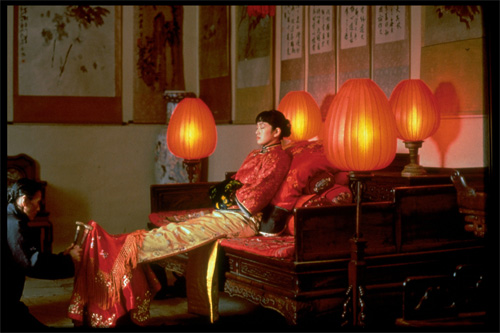
Completing a loose trilogy that began with Red Sorghum and Ju Dou, Zhang Yimou’s grim 1991 adaptation of a novel by Su Tong once again stars Gong Li as a young woman who marries a much older man, and once again tells a story that explicitly critiques Chinese feudalism and indirectly contemporary China. This time, however, the style is quite different (despite another key use of the color red) and the vision is much bleaker. The heroine, a less sympathetic figure than her predecessors, is a university student in the 1920s who becomes the fourth and youngest wife of a powerful man in northern China after her stepmother can no longer afford to pay for her education. She quickly becomes involved in the various intrigues and rivalries between wives that rule her husband’s world and family tradition: each wife has her own house and courtyard within the palace, and whoever the husband chooses to sleep with on a given night receives a foot massage, several lighted red lanterns, and the right to select the menu for the following day.
The film confines us throughout to this claustrophobic universe of boxes within boxes, where wives and female servants devote their lives to scheming against one another; the action is filmed mainly in frontal long shots. Zhang confirms his mastery and artistry here in many ways, some relatively new (such as his striking sound track), though the cold, remote, and stifling world he presents here doesn’t offer much emotional release.

Red Psalm
East Side Story, a recent documentary about communist musicals, assumes that communist-bloc directors were just itching to make Hollywood extravaganzas and invariably wound up looking strained, square, and ill-equipped. But Red Psalm (1971), Miklos Jancsó’s dazzling, open-air revolutionary pageant, is a highly sensual communist musical that employs occasional nudity as lyrically as the singing, dancing, and nature; within its own idioms it swings as well as wails. Set near the end of the 19th century, when a group of peasants have demanded basic rights from a landowner and soldiers arrive on horseback, Red Psalm is composed of only 26 shots, each one an intricate choreography of panning camera, landscape, and clustered bodies. (With a running time of 84 minutes, this adds up to an average of three minutes per shot.) Jancsó’s awesome fusion of form with content and politics with poetry equals the exciting innovations of the French New Wave in the 60s and early 70s. The music, ranging from revolutionary folk songs to “Charlie Is My Darlin’,” will keep playing in your head for days, and the colors are ravishing. The picture won Jancsó a best director prize at Cannes, and it may well be the greatest Hungarian film of the 60s and 70s, summing up an entire strain in his work that lamentably has been forgotten in the U.S. The Hungarian title means “And the People Still Ask,” and one of Jancsó’s characteristic achievements is to create a striking continuum between past and present, a sense of immediacy about history that can be found in few other period films. This suggests that the charge of formalism that has frequently been leveled against him may partially stem from an inability to fully comprehend his historical and political meanings —- combined with an understandable effort to become intoxicated by the stylistic virtuosity and beauty.
Red Sorghum
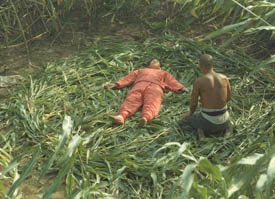
Winner of the Golden Bear at the Berlin film festival, Zhang Yimou’s 1987 feature from the People’s Republic of China mixes local history and legend. It follows the adventures of a young girl (Gong Li) who is sold by her father to an elderly and wealthy leper, then is carried off by a chair bearer posing as a highwayman, and eventually becomes the head of a sorghum-wine distillery. This is the first feature directed by the cinematographer of Yellow Earth, The Big Parade, and Old Well (as well as the lead actor of the latter film). Zhang, one of the leading members of the famous “Fifth Generation” of Chinese filmmakers, has been widely considered the most versatile of the group because of his background in cinematography and acting, and many of the most striking virtues of Red Sorghum are visual — handsome ‘Scope compositions of landscapes and sorghum waving in the wind, and a deft use of color filters. Narrated offscreen by the heroine’s grandson, the plot is set in the late 1920s and early 1930s and ends with the Japanese invasion of the area. While the action is often intriguing — lyrical in the early sections, whimsical toward the middle, and bloody and suspenseful toward the end — the overall narrative gets broken up quite a bit by the episodic structure, and the film registers mainly as detachable set pieces. This is the film debut of Gong Li, who went on to become one of the major stars of mainland Chinese cinema in such subsequent Zhang Yimou features as Ju Dou (1990), Raise the Red Lantern (1992), The Story of Qi Ju (1992), and Shanghai Triad (1995), as well as Chen Kaige’s Farewell, My Concubine (1993) and Temptress Moon (1996), which also helped to seal and extend her international reputation. Like some of Zhang’s other early features with her, especially Ju Dou and Raise the Red Lantern, Red Sorghum is concerned both covertly as well as more directly with the persistence of feudalism in the life of mainland China. (JR)
Repulsion

Roman Polanski’s first film in English (1965, 105 min.) is still his scariest and most disturbing — not only for its evocations of sexual panic, but also because his masterful employment of sound puts the audience’s imagination to work in numerous ways. It is also the most expressionistic of his early black and white features, employing wide angles that become increasingly wider and deep focus along with other visual strategies to convey subjective states of mind in which dreams, imagination, and everyday reality are worked into the same continuum, and a conventional apartment gradually assumes the shape and form of a tortured consciousness. Catherine Deneuve gives one of her most impressive performances as a quiet and quietly mad Belgian manicurist living with her older sister in London and terrified of men. When the sister and her boyfriend, whose lovemaking in an adjacent room already disturbs and frightens her, take off on a holiday, her fears and her isolation in the apartment are allowed to fester along with the uncooked food (including a sinister-looking rabbit), with increasingly violent and macabre results, as her madness becomes more and more apparent.
As narrative this works only part of the time, and as case study it may occasionally seem too pat, but as subjective nightmare it’s a stunning piece of filmmaking put together with expertly calibrated shocks and a gradually developing sense of dread. In many respects, this thriller became something of a template for many of Polanski’s subsequent ventures into horror and his tales of isolation and claustrophobia, including such disparate works as The Tenant in 1976 (in which Polanski himself played the starring role) and The Pianist over a quarter of a century later. Yet ironically, in his 1984 autobiography, Polanski wrote that he and his cowriter Gerard Brach regarded Repulsion mainly as “a means to an end” —- namely, a commercial success that would enable them to finance Cul-De-Sac (1966) —- a much more personal (if less commercial) film in English that would star Deneuve’s sister Françoise Dorléac. (JR)
Roger & Me

Michael Moore’s black-comedy documentary (1989) about the consequences of massive layoffs by General Motors in Flint, Michigan, and Moore’s unsuccessful attempts to buttonhole Roger Smith, the General Motors chairman, to bring him to Flint to see what his actions have wrought, is certainly impressive for a first feature, as well as bracing proof that movies can be both hugely entertaining and politically sharp at the same time. Mixed in with Moore’s justifiably lethal anger, however, is a certain sense of glib superiority over Flint’s victims as well as its corporate villains that one is invited to share, and the breezy results, while often exhilarating and never boring, are not exactly devoid of cheap shots and journalistic oversimplifications —- qualities that might be said to carry over into Moore’s second big success, Bowling for Colombine, thirteen years later, where despair of a certain kind periodically competes with the joy of one-upmanship. Thus the cheerful heartlessness of Reaganism that is this film’s subject is not entirely irrelevant to its own methods, and Dave Kehr in the Chicago Tribune aptly dubbed the film around the time of its initial release as “the first feel-good atrocity film”.
Roger and Me’s cavalier manner of juggling certain time frames and sequences of events also led one reviewer at the time —- Harlan Jacobson in Film Comment —- to dismiss Moore as something of a charlatan, and Pauline Kael cited Jacobson’s evidence in the course of making her own detailed case against the film. Yet the fact that General Motors wound up using Kael’s review in a brochure to dismiss Moore’s charges revealed how readily many commentators were ready to reject the justifiable rage and bypass the irrefutable facts in Moore’s muckraking because of his breezy methods and cheap shots —- a clear case of throwing the baby out with the bathwater that arguably persisted in some of the American dismissals of Bowling for Colombine. In both cases, Moore’s populist desire to entertain, which ensured his commercial success and the wider reach of his ideas, also entailed some self-aggrandizement as well as a certain number of journalistic shortcuts. As questionable as these factors remain, it’s worth asking one’s self which is more important in the final analysis —- corporate greed (or, in the case of Bowling for Columbine, American’s gun problem) or Michael Moore’s ego trip. (JR)
Rosetta

From its opening seconds, this feature from Belgian brothers Jean-Pierre and Luc Dardenne, winner of the Palme d’Or at the 1999 Cannes film festival, was surely the most visceral filmgoing experience of that year, including all of Hollywood’s explosions and special-effects extravaganzas. It concerns the desperate efforts of the 18-year-old title heroine (played by Emilie Dequenne, then a remarkable nonprofessional), who lives in a trailer park with her alcoholic mother and suffers from stomach cramps, to find a steady job; she particularly hopes to work at a waffle stand whose current employee has romantic designs on her. This may sound like the grimmest sort of neorealism, but the Dardennes keep the story so ruthlessly unsentimental and physical it would be a disservice to describe it as neo anything. You feel it in your nervous system before you get a chance to reflect on its meaning — almost as if the Dardennes were intent on converting an immediate experience of the contemporary world into a breathless theme-park ride — and it makes just about every other form of movie “realism” look like trivial escapism. It’s certainly not devoid of psychological nuance either, and it had such an impact in Belgium that a wage law for teenagers, which passed in November 1999, is known as “the Rosetta plan.” (JR)
Russian Ark
This Alexander Sokurov feature (2002) is one of the most staggering technical achievements in the history of cinema — a single shot lasting 95 minutes while moving through 33 rooms in the world’s largest museum, the Hermitage in Saint Petersburg (which also encompasses the Winter Palace). Part pageant and museum tour, part theme-park ride and historical meditation, it traverses two centuries of czarist Russia as smoothly as it crosses the Hermitage and even periodically moves outside of it, with the offscreen Sokurov engaged in an ongoing dialogue with an on-screen 19th-century French diplomat (apparently suggested by Adolphe, marquis de Custine). Sokurov used close to 2,000 actors and extras and three live orchestras in making what may be the world’s only unedited single-take feature as well as the longest Steadicam sequence ever shot. (Reportedly only one previous take of the sequence was even attempted, after lengthy and detailed rehearsals of all the participants, and it apparently failed due to the sub-degree temperature outside.) This is also the first uncompressed high-definition film recorded on a portable hard-disk system rather than film or tape before being transferred to 35-millimeter, and, along with Sokurov’s earlier innovative experiments with optical distortions and perspective in some of his earlier features such as Mother and Son and Whispering Pages, it marks him as a kind of 19th century modernist —- a filmmaker who, like Manoel De Oliveira in a very different way, combines an acute sense of the past with a very up-to-date sense of how to convey it.
The only problem with his technical feats is that they threaten to overwhelm the film’s content, both as complex historical commentary and as aesthetic and theoretical gesture. As critic J. Hoberman has suggested, this is an anti-October, challenging Sergei Eisenstein’s reliance on montage while using the Winter Palace as a gigantic set. All of which is to say that we’re only just starting to grasp the dimensions of this formidable achievement, although it’s worth adding that the surprising and virtually unprecedented commercial success of this film in the U.S. strongly indicates that Sokurov’s technical mastery is not merely an achievement to be enjoyed by specialists of cinema or Russian history.


